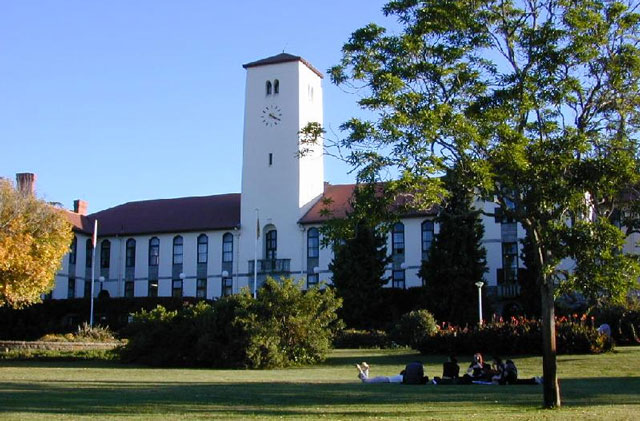
It has been 25 years since the first Internet connection was established in South Africa.
Saturday, 12 November 2016 marks a quarter of a century since the first Internet protocol connection was made between the computer centre at Rhodes University in Grahamstown in the Eastern Cape and the home of early Internet pioneer Randy Bush in Portland, Oregon in the north-western United States.
The now-retired Mike Lawrie, who at the time was director of computing services at Rhodes, said in a recent e-mail to a South African Internet community mailing list: “On 12 November, give a smile and a cheer, for the Internet will have been in South Africa for exactly 25 years.”
Lawrie has good reason to be excited: he played a pivotal role in bringing the Internet to South Africa. He penned a detailed overview in 1997 of how it all came about and is well worth a read for anyone interested in South African telecommunications and Internet history.
TechCentral’s former deputy editor, Craig Wilson, sat down with Lawrie at his home in Pretoria in 2011 and recorded a detailed account of just how instrumental he (Lawrie) and his colleagues had been in getting South Africa and, eventually, the rest of the continent online. That piece is reproduced in slightly shortened form below.
“I suppose I’ve always been a technical person,” Lawrie said by way of introduction. “My early career involved fixing Hollerith machines, and I took to it like duck to water. Then I got a lucky break. I’ve had luck throughout my life. I was given the opportunity to be the site engineer for the computer department at Rhodes University in 1965.”
Lawrie packed up his house and he and his wife of only few months, Christine, spent the next four years in Grahamstown. Being so isolated, the university wanted someone on site to do maintenance. Having grown up in Cape Town, the two then moved back to the Mother City, and then to Johannesburg, before he got a job offer from Rhodes.
He returned in 1971, and admits he started doing “all sorts of weird things with the computing service”.
“One of the things I guided the university away from was punched cards [used in machines of the sort Lawrie had previously repaired]. I set up their online, interactive computing system. It was very primitive by today’s standards.”

Mike Lawrie
In those days, networks were limited to 10 characters per second — or about 75 bytes a second. “Voltages were such that if you wet your thumb you could feel the pulses in the wires. I think it was around 70V or so.
“At that stage, the physics department at Rhodes had a visual display unit that worked with RS232 communication links. I used the PABX wiring at the university to connect that terminal to the mainframe,” said Lawrie. “Then we looked at the technical side and were pleasantly surprised. The pulses going through the line are square, okay? They’re either on or off. It has to be one or zero. But the signals are never perfect. Over 100m or so of copper, the pulses were still coming out in good shape.”
This prompted Lawrie to consider trying something a little bit bigger.
The next step
He managed to persuade Telkom — “which was really the Post Office at the time” — to install local leads into his house. There was only one telephone exchange in Grahamstown and he was in what was called the “minimum radius area”, so the copper wire itself went from the university to the High Street exchange in town, then to his house. “Lo and behold, signals at my house were adequate, too.”
Lawrie now had a multi-access system spread over about 2km of copper wire. “It worked at about 4 800 or 9 600 bits per second.”
He then developed an e-mail system on Rhodes’s mainframe computer, a Control Data Cyber machine. “The Cyber was very flexible in its networking capabilities.”
Back then, commercial networks tended to use IBM mainframes, which Lawrie said were expensive and proprietary. “By pure chance, we found for the low cost of a terminal we could network into houses around Grahamstown. It was great for the academics, who suddenly didn’t have to stay late to work.”
I have no idea what it’s like to take drugs, but we were on a high for months and months
Only a small number of people who used the Cyber mainframe needed e-mail, but the computer department employees were given access, too, and soon found the advantages. “You didn’t have to interrupt staff; they could reply at their convenience. And soon, they could reply from home. It just worked.”
In 1985, Lawrie recalls, a committee of university vice chancellors decided to network South Africa’s universities, influenced no doubt by similar moves in Europe, England and the US.
“I was part of the technical subcommittee,” he said. “After two years, it was still going nowhere — there were too many differences, mostly political. It was still the era of the mainframe computer and certain IT directors were extremely possessive. There was inevitable friction between newly developing computer science departments and other faculties.”
It was clear the networking committee wasn’t going to get anywhere. But Lawrie and his team kept tinkering. Using a VAX computer from Digital Equipment Corp, installed at the physics department, Lawrie and a team from IT managed to link it to the system he was maintaining. “We got a package that ran on the VAX and made it behave like an IBM mainframe, which made it possible to exchange files, and e-mail, between the machines.”

Rhodes University in Grahamstown
Lawrie explains that e-mail was now delivered to the user rather than having to be fetched. He teamed up with his opposite number at Potchefstroom University, Philip Welman, who’d also been the chairman of the failed committee.
“Welman and I got on very well,” Lawrie said. “He agreed to try and link our two computers. He was running IBM mainframes and we were running our Cyber, but we knew we could handle the IBM protocols because of our experience with VAX. Philip and his staff were already using e-mail like we were, and loved the convenience.”
‘Do you read me? Over’
Soon thereafter, Wits University, Pretoria University, Potchefstroom and the Council for Scientific and Industrial Research (CSIR) were all networked, but all via IBM systems, and so hadn’t had to overcome any protocol conflicts.
But Lawrie and Welman had demonstrated that cross-protocol communication wasn’t just possible, they’d done it. E-mail sent from Rhodes could reach Wits, Pretoria and the CSIR, all via Potchefstroom. “In addition, people like Justin Jonas, who oversaw the VAX in the physics department at Rhodes, could also now send mail to Potch, and onwards.”
Lawrie said this proved a real breakthrough because other universites, like the University of Cape Town and Stellenbosch University, ran protocols knowns at DECNet using VAX machines. Suddenly, there was the potential to link all of them.
“We realised what we were doing resembled a network called Bitnet.” Bitnet — which itself resembled another network called Usenet — started with a connection between City University of New York and Yale. They replied to correspondence from Lawrie and encouraged him to try and expand the growing SA network.
Around the same time, the CSIR started another academic research networking project called Uninet. What is now the National Research Foundation (NRF) — then called the Foundation for Research Development — was run by a man called Rhein Arndt, someone Lawrie describes as a “network visionary”.

Alan Barrett
Arndt provided seed money and persuaded the universities to stop chasing the committee and instead throw their weight behind Uninet, which was headed by Vic Shaw, who’d come out of retirement to run the project. “Vic charmed the universities to go along with it.”
Though there was now funding for a national network, and the requisite infrastructure, the system didn’t allow for the crossing of protocol boundaries. “I took my response from Bitnet to the board, and said, with a big smile: ‘This is it. We can change very little and get international mail, free, for academics.’”
But the board rejected Lawrie’s proposal, fearing that no sooner would the network come online that a developed nation would complain about SA’s inclusion and shut it down. Lawrie said there was some justification for this fear, because the University of Cape Town had linked one of its machines into a Unix network known as UUNet (not to be confused with the company) and had been disconnected three weeks later.
“I had phoned the lady from Bitnet who had replied [to my correspondence] and had asked her if she realised they were dealing with South Africa. I asked if their offer of allowing us to join their network, assuming we could get the infrastructure in place, was still good? She said it was. I was livid that the committee wouldn’t accept that,” said Lawrie.
Despite the setback, and despite the fact that none of the people involved were being paid to try and establish the network and had to work their real jobs on the side, Lawrie and his technical team, Dave Wilson and Francois Jacot-Guillarmod, tried to find a workaround.
Lawrie wrote to a company called SRI International in Silicon Valley. “They seemed to be the folk controlling the-then Internet”. Lawrie asked if South Africa could join, and months later received an apologetic and friendly response, but one that nevertheless said “no”. SRI said its network was a closed academic research network, but that there were five other networks Lawrie could try.
Man’s best friend
“The fifth, and last, I tried was FidoNet, which had been developed by a chap called Tom Jennings. He’d developed a mail system that would push messages to different bulletin boards, which were popular in those days. Each city would have a central node and late at night it would batch all the mails together, Zip them up and send them to another central node that would unpack them, keep what was destined for it and forward the rest.”
As an added bonus, FidoNet’s protocols allowed information to flow both ways. “We then found there was an existing South African FidoNet community,” Lawrie said. “It wasn’t big, or particularly well organised, but at least we could prove the system worked. It wasn’t that reliable, but it would eventually tie in to the Internet. We persuaded the FidoNet community that Rhodes would act as an international node, forwarding mail from Johannesburg, Pretoria and so on to the US.”

Lawrie said his team “jippoed” the mail system to recognise when someone on the South African network sent a message to an international address. The system would then pack the mail in a particular way, put it on Wilson’s PC and make it look like it had been typed into a FidoNet system. It was then forwarded to a guy called Randy Bush in Portland, Oregon. He would get it into the FidoNet system there.”
With a rudimentary but functional network up and running, Lawrie’s work began to garner attention from other South African universities. Two men in particular, Alan Barrett from the University of Natal, and Chris Pinkham from the University of Cape Town (who both ended up working at Amazon.com) were intrigued at the possibility of using their universities’ own systems to send international e-mail.
However, both universities used different systems, so protocols had to be converted in a process Lawrie calls “munging”. It worked, and soon their mails were making their way onto the FidoNet network, too. With various minor alterations, the network ran that way for about a year.
In 1991, Lawrie found out about TCP/IP protocols and had managed to secure a sign-on at the University of Delaware.
“We could use an X.25 system that the Post Office had provided. X.25 was an international standard but there was an awful gateway between South Africa and the US. However, it worked. I could now log into Delaware’s system and could do things on the Internet.”
Lawrie said the experience was “absolutely phenomenal” and that he could use the file transfer protocol with his file space on the VAX machine, and could even mail himself binary files. “Granted, that was through the long route. Mails would go from Delaware, to Randy in Oregon, to a Unix system, and then over FidoNet.
The lack of cooperation and vision from the telecommunications operators was amazing
“I think Chris and Alan were miles ahead of me in terms of their knowledge of protocols, so we decided we would try and link them into a Cyber that was now running TCP/IP protocols. We spent R400 buying a package that would make a PC behave like a router. Cisco in California were making routers, but wouldn’t have anything to do with SA, so we couldn’t buy routers, but back then we couldn’t afford them anyway.”
At first their attempts failed, until Barrett suggested a TCP/IP package called PC Route, which was public domain, open-source software. “I was convinced it wouldn’t work. After all, it was free. It worked from day one.”
Suddenly, the network could support mail protocols like SMTP. “We then needed to persuade Vic Shaw and Uninet to fund the line.” At the time, a model of networking standards called Open System Interconnection (OSI) was gaining ground. While Uninet tried to decide whether to embrace OSI or TCP/IP, more universities joined the network and traffic increased exponentially.
Bankrolled
By this stage, the system was costing in the region of R90 000/month, and that was simply for e-mail. Lawrie, worried that the costs would cripple the network, decided to work out the average cost of an e-mail so he could figure out how to bill researchers using the system — if necessary. “It worked out at 1c or 2c per e-mail message. There was just that much traffic.”
Eventually, Shaw at Uninet went to the Post Office and requested a leased line to Bush in Oregon. “In that era, before Telkom, there was this thing called the ‘third-party rule’. If you and I had a dedicated circuit between us, and I had another to someone else, I could use both to communicate with each end, but I couldn’t let you connect through me to point C.”
I could now log into Delaware’s system and could do things on the Internet
At first the rule meant that banks couldn’t interconnect their branches, and so an “escape clause” was implemented that made exceptions for “common interest groups”. Uninet, on the grounds that it connected universities, was recognised by the Post Office as a common interest group. After various hiccups, Lawrie got his line, and the costs dropped to R30 000/month.
On 12 November 1991, the first Internet protocol packets started flowing out of South Africa on the leased circuit. Lawrie said it’s “amazing” it happened at all, or at least it seemed so at the time. “The lack of cooperation and vision from the telecommunications operators was amazing. They couldn’t see that in the long run they’d make money rather than lose it if they supported the technology.
“It was a remarkable environment,” said Lawrie. “I have no idea what it’s like to take drugs, but we were on a high for months and months. It wasn’t a formal breakthrough, we weren’t the first or anything, but to have it here … felt great.”
Reflection
Lawrie concedes that he and his team made mistakes, but he said they were particularly careful about ensuring things worked properly before putting them to use.
“I look back on it now and it seems ridiculous to have proposed taking a mainframe computer — a scientific number cruncher, made by Cray — and using that as a central point to gather all South African universities’ mail, then manipulating and moving it into a PC in such a way that the PC thinks someone typed it in. Then we’re going to dial into the furthest end of the US, where another PC will unpack it and repackage it, if necessary, for another network, before routing it to the Janet network in UK, or European networks, or anywhere.”
Lawrie said he and many others worked incredibly hard as the network grew. He said the amount of assistance they received from the US was enormous. “In the evenings, I would sit at my terminal at home [an Apple II with custom software written by Lawrie] and exchange mail with people at work, at their desks, during the day in the US. The help, advice, comments, support and interest were utterly amazing.”
Links to Lesotho, Botswana, Mozambique, Zambia, Zimbabwe and countries as far flung as Ghana followed. “I remember I visited Ghana in 1993 and we’d set up a FidoNet system. We asked around for an e-mail address, and someone gave us the address of a woman named Francis Li. We sent the message and 10 minutes later, when we sent more messages, she had replied. The reaction was incredible.” — (c) 2016 NewsCentral Media
